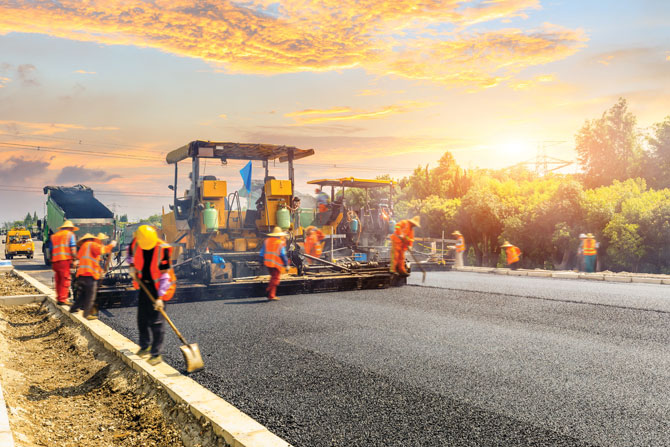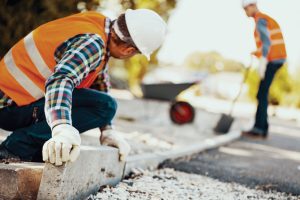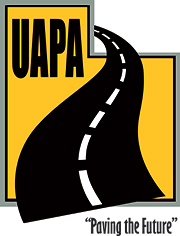It’s no secret that the U.S. infrastructure is old. Rebuilding it will take money, but federal, state and local governments have not allocated enough money for several decades. Even though roads are vital, people take them for granted, paying for maintenance isn’t flashy, and other budget items seem more important. However, the situation has finally changed. The U.S. Senate passed the infrastructure bill in August, 69-30, with 19 Republicans joining Democrats and one Republican not voting. Then the bill had to go back to Congress as H.R. 3684, the Infrastructure Investment and Jobs Act (IIJA). The House of Representatives passed it Nov. 5, 2021.
President Biden signed IIJA into law Nov. 15, 2021, on the south lawn at the White House; about 800 people were there to watch. Those attending included Democrat and Republican lawmakers, governors and mayors from throughout the country, and also Utah’s Mitt Romney.
Now that the bill has passed, the goal is to put money into America’s infrastructure so the U.S. can become globally more competitive. About $650 billion of the money being allocated is being directed away from existing projects and funds.
What does the law contain, and what will happen next?
The bill authorizes $1.2 trillion in spending, an amount that is $550 billion higher than baseline levels. Of that $550 billion, $283.8 billion will be for transportation. According to the Bipartisan Infrastructure Investment and Jobs Act Summary, the bill has money for the following categories, ranked by size:
- Roads, bridges and major projects
- Passenger and freight rail
- Public transit
- Airports
- Ports and waterways
- Safety and research
- Low-carbon and zero-emission school buses and ferries
- Electric vehicle charging
- Reconnecting communities.
Every category has billions set aside for it. At $110 billion, the largest category in the bill is roads, bridges and other projects. The smallest amounts are $7.5 billion for EV charging stations and the same amount for buses and ferries. Also, the bill includes funding for existing programs and policy reforms.
President Biden chose Mitch Landrieu, former mayor of New Orleans (2010-2018) and former Louisiana lieutenant governor as the infrastructure coordinator. Since he was a key player in helping New Orleans recover after the 2005 devastation caused by Hurricane Katrina, his experience gave him the background to supervise the federal implementation of IIJA through agencies like the Departments of Transportation and Energy. Officials will set up new programs to distribute the money to state and local departments.
One part of the bill is of particular interest to anyone who builds roads. The Department of Transportation has been asked to keep the Highway Trust Fund solvent by coming up with a national motor vehicle per-mile fee whose purpose will be repairing and maintaining the country’s roads.
Now is when the important work begins: spending the money and, finally, working on long-postponed projects to improve the U.S. infrastructure. Getting the money allocated has taken a long time, and funding levels are lower than President Biden had hoped for, but some beats none. Utah will do its best to get the utmost out of every dollar spent.
The U.S. is not the only country to struggle with paying for its roads. Many of Europe’s problems are the same ones faced by the U.S.: inadequate fuel tax revenues, high transport emissions and heavy traffic congestion. Also, like America, Europe is wary of China.
U.S. roads get heavy use. In 2019, the U.S. Department of Transportation estimated there were more than 272 million registered vehicles. That puts the U.S. in the top five countries for people owning motor vehicles.
Unfortunately, road maintenance hasn’t been a high priority here. In 2009, 14% of U.S. roads were in poor condition. In 2017, the percentage had risen to 20%. That affects business revenue; a CarParts blog estimated the loss at $240 billion. More importantly, poor road conditions cause a third of all fatal road accidents annually. Also concerning? Bad roads are responsible for vehicle damage that costs $380 per driver annually to repair.
The Federal Highway Administration analyzes pavement conditions functionally and structurally, then categorizes their condition as good, fair or poor. “Good” means the road’s expected life is 8+ years, and it only needs preservation work. “Fair” means road deterioration is expected in 4-8 years, and the road needs rehabilitation and preservation work. “Poor” means deterioration is expected in less than 4 years, and the road needs reconstruction and heavy road rehabilitation.
How do Utah’s road conditions compare with the rest of the country?
- Good: 38%
- Fair: 39%
- Poor: 22%
Land sale revenue originally allowed the federal government to build U.S. roads, but the federal government currently manages only 3% of roads. States own 19.6% of public roads, most of which are interstate highway systems. City and county governments own the balance, 77.4%.
Rethinking how to pay for road repairs and maintenance is long overdue, and money directed toward Utah by the new infrastructure bill will certainly help. Since the U.S. has plenty of roads, repairing and maintaining what we currently have is what will give taxpayers the best return on investment.










